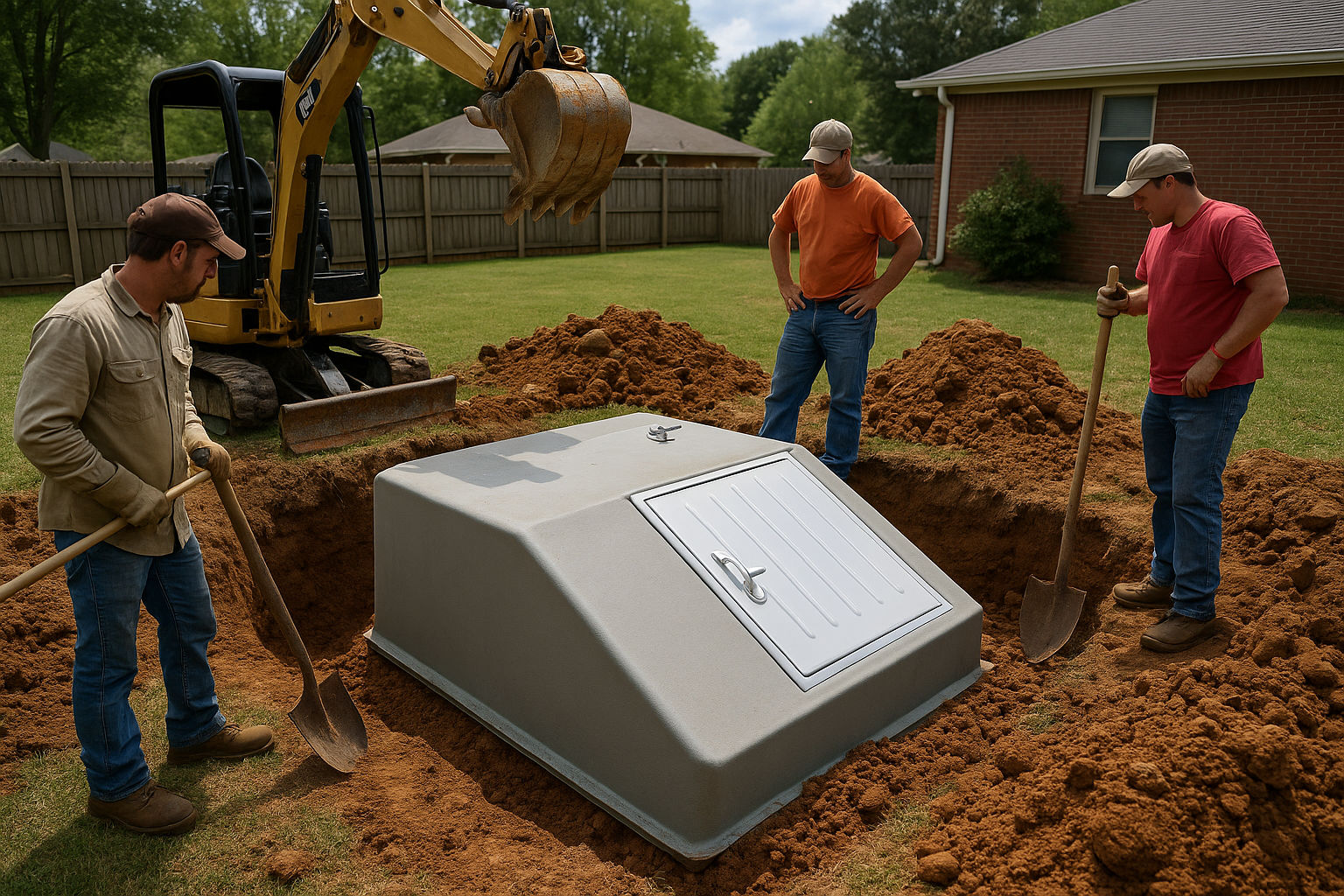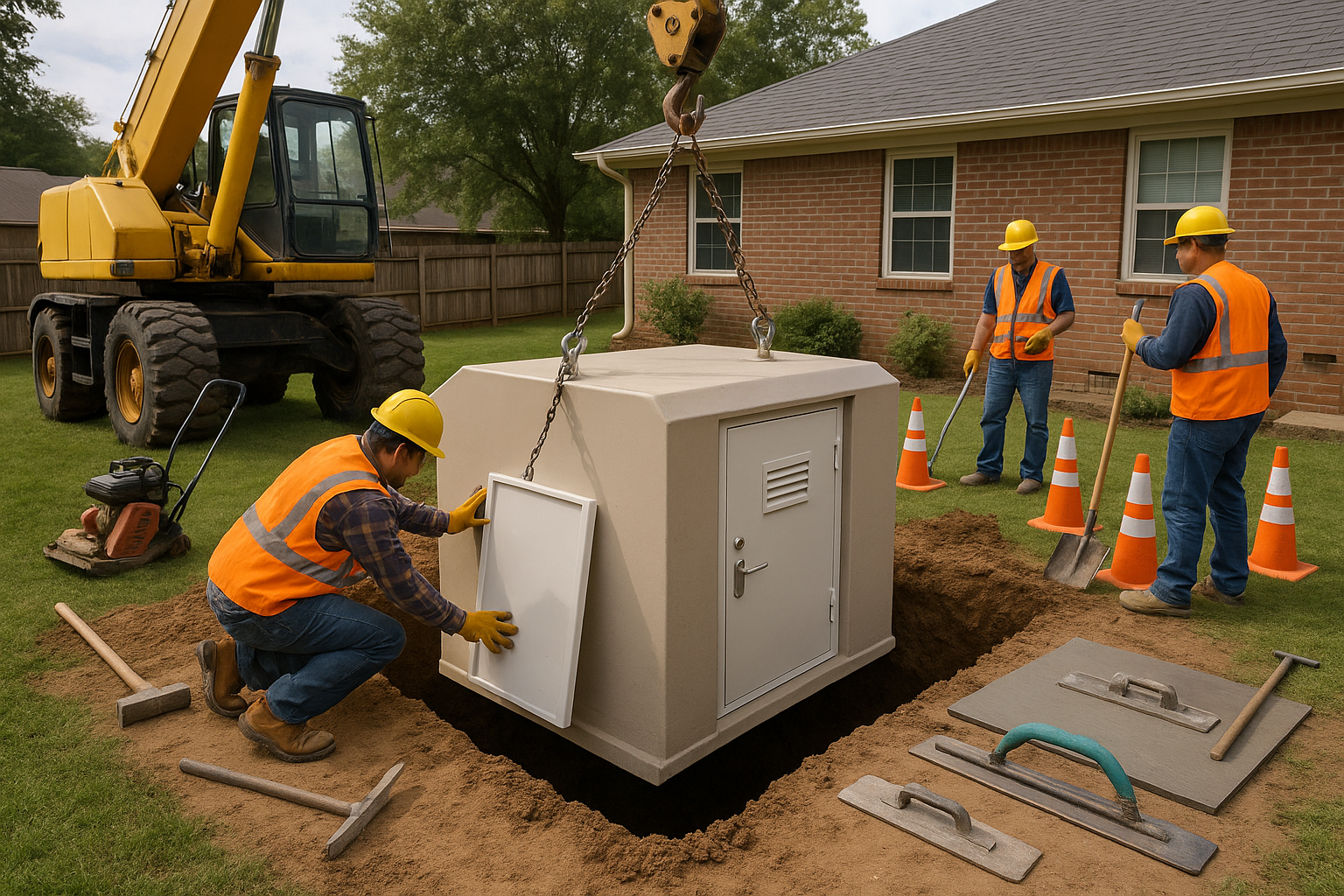Installing an Underground Storm Shelter: What to Expect


Understanding the Storm Shelter Installation Process in Alabama
If you’ve ever watched the Alabama sky turn dark and felt that familiar knot in your stomach, you’re not alone. Severe storms can move in quickly, and having a safe, reliable place to go makes a world of difference for families across the state. That is why many homeowners consider installing underground storm shelter solutions, a long-term safety investment that provides real peace of mind when weather conditions become unpredictable. This option is especially popular among those researching underground storm shelter cost and comparing storm shelter prices.
The challenge, of course, is understanding what storm shelter installation actually involves. Homeowners often worry about yard disruption, costs, permitting, and whether their property is suitable for an in ground storm shelter. These concerns are completely valid, and learning the steps ahead of time helps remove guesswork. In this guide, we walk through each major stage of the installation so you know exactly what to expect from start to finish.
By the end, you’ll feel confident and fully prepared to move forward with a storm-ready upgrade for your Alabama home. For more insight into how these structures function, many homeowners refer to resources like this guide on how storm shelters work in Alabama.
Let’s dive into the process and make this decision easier for you.
What to Expect When Installing an Underground Storm Shelter
When you decide to move forward with installing an underground storm shelter, the process begins with careful planning and site evaluation. Installers assess your property layout, soil type, and drainage conditions to ensure the underground tornado shelter will remain stable and accessible for years to come. This first phase matters because choosing the right installation spot prevents long-term issues such as soil shifting or water intrusion.
Homeowners often appreciate understanding the timeline early. Most underground storm shelter installations take a single day once preparations are complete. The days leading up to installation include essential tasks like utility marking and permit confirmations based on local Alabama regulations. These steps help create a smooth schedule from start to finish.
As you learn more about storm shelters Alabama options, understanding the installation process becomes even more beneficial. Not only does it help you prepare your yard, but it also helps set realistic expectations for the cost of underground storm shelter options and the final outcome. Some homeowners worry about how their yard will look afterward, but installers typically backfill, level, and clean up the area to ensure the space appears neat and well prepared.
The Complete Process for Installing an Underground Storm Shelter
Each step of the installation process is designed to ensure your storm cellar is safe, durable, and ready for emergency use. Below is a detailed walkthrough to help you feel prepared for what your installation day will include.
How the Initial Property Assessment Works
Before excavation begins, installers conduct a full property assessment. This initial step matters because it determines whether your selected installation site will remain secure over time. Installers evaluate slope, soil density, drainage patterns, and yard layout to identify the most suitable location. If the soil is loose or prone to flooding, adjustments are recommended to ensure long-term safety.
Much of Alabama’s clay-heavy soil requires proper leveling to maintain structural stability. Installers may also discuss long-term concerns such as runoff direction, ventilation placement, or access paths. A simple walkthrough helps you understand how your underground storm shelter will fit into your property layout and what preparations may be needed.
Many homeowners reviewing underground storm shelter cost benefit from this step because it provides clarity on potential adjustments that could influence overall pricing.
How the Utility Marking Process Happens
Utility marking is one of the most important safety steps in the storm shelter installation process. This step matters because excavating without proper utility identification can cause serious damage to gas, water, or electrical lines. Installers coordinate with local Alabama utility providers to locate and clearly mark all underground lines.
Once utilities are marked, the installer reviews the positioning and determines whether excavation plans need to be adjusted. Homeowners are often surprised by how many lines cross their yard, but completing this step early prevents delays and keeps your installation crew safe. Proper marking also ensures your underground tornado shelter can be installed efficiently.
Utility marking supports compliance with guidance from organizations like Ready.gov and the Alabama Emergency Management Agency.
How the Excavation and Ground Prep Begin
After utilities are marked, excavation begins. This step is essential because proper digging ensures the shelter sits level and secure underground. Installers use excavators or trenching equipment to create a pit sized specifically for your shelter model. Alabama’s mix of red dirt and clay requires careful shaping to prevent collapsing edges during excavation.
Once the pit is dug, the base is leveled and compacted. Installers may add gravel for enhanced drainage, especially in moisture-prone yards. Gravel helps reduce long-term erosion and improves the durability of your in ground storm shelter. Homeowners researching tornado shelter cost often appreciate that this step improves the lifespan and safety of the shelter.
This part of the process moves quickly, often taking only a few hours from the time excavation begins.
How the Underground Shelter Placement Works
Once the ground is prepared, the underground storm shelter is carefully lowered into place. This placement stage matters because it ensures the shelter is level, stable, and structurally supported. Installers use cranes or excavators to guide the shelter into the pit and secure it in the proper position.
After placement, installers check door clearance, ventilation alignment, and emergency exit functionality. Even small alignment issues can affect long-term performance, so precision is essential. Proper placement also reduces the risk of water intrusion, uneven settling, or door misalignment. This stage lays the foundation for long-term usability and safety in your storm cellar.
If you are comparing storm shelter prices, understanding this stage can help you evaluate installation quality between different providers.
How the Backfilling and Final Grading Proceed
Once the shelter is in position, installers begin backfilling the area around the unit. Soil is added in layers and compacted to increase long-term stability. This step matters because proper backfilling prevents future settling and ensures strong support for the shelter. Installers also grade the surrounding ground to direct rainwater away from the entrance.
Homeowners often appreciate how tidy the final result appears. Installers typically smooth and level the yard, adding gravel or concrete around the entrance based on your preference. This finishing work helps create a safe and durable entryway for your underground storm shelter.
Many homeowners exploring storm shelters Alabama options choose to add pathways, mulch, or simple landscaping to enhance the shelter’s accessibility and appearance.
Real-World Uses and Practical Applications
Once your underground storm shelter is installed, its value becomes immediately obvious. Families often use these shelters during tornado warnings or severe weather events, providing safety and peace of mind. The shelter becomes a reliable gathering point where family members can prepare and stay secure.
Emergency supplies such as water, blankets, radios, and flashlights can be stored inside the shelter for quick access. This makes the underground tornado shelter an ideal location for emergency preparedness. Families living in rural or siren-limited areas particularly appreciate the fast access and high safety rating of an in ground storm shelter.
Storm-ready storage, quiet space during severe weather, and simple day-to-day security are among the most common uses for these shelters. Each use reinforces the value of your investment and highlights why installing underground storm shelter options has become increasingly popular across the state.
Best Practices and Common Mistakes to Avoid
To get the most from your storm shelter installation, it helps to follow a few best practices and avoid common mistakes. Proper care ensures your shelter remains dependable year after year.
• Choose the right installation location: Select an area that supports good drainage and stable soil. Avoid low spots likely to collect water.
• Keep ventilation clear: Check vents regularly for debris buildup. Clear airflow is essential for safe use.
• Maintain accessible entry paths: A clear path allows quick access during emergencies. Trim shrubs and remove clutter routinely.
• Schedule periodic inspections: An annual check can identify early settling or minor wear. Preventative care supports long-term durability.
These practices enhance the lifespan of your underground storm shelter and reduce the chance of unexpected issues.
Final Thoughts and Closing Takeaways
Installing an underground storm shelter is one of the most reliable ways to protect your home and family during Alabama’s unpredictable storm seasons. Understanding each installation step, from evaluation to excavation to final grading, helps you feel confident in your decision and ready for the process ahead.
With proper planning and a trusted installer, your storm shelter becomes a secure, long-lasting investment. Whether you are comparing storm shelter prices or assessing the cost of underground storm shelter options, this guide equips you with the knowledge needed to take the next step. If you are ready to explore installation options, consider connecting with an experienced Alabama shelter specialist for a full property assessment and tailored recommendations.
Frequently Asked Questions About Installing an Underground Storm Shelter
1. Is installing an underground storm shelter safe for Alabama clay soil?
Yes, underground storm shelters work well in clay-heavy soil, which is common across Alabama. Installers use compacting and leveling techniques to ensure proper stabilization, and gravel bases help support drainage and long-term durability.
2. How long does underground storm shelter installation take?
Most installations are completed in a single day once preparation is finished. Utility marking, planning, and scheduling occur in the days leading up to installation. The excavation and placement themselves are usually completed efficiently.
3. Can underground storm shelters flood during heavy rain?
They can if installed improperly or in low-lying areas. To prevent water intrusion, installers grade the soil, elevate entrances, and add gravel around the base. Following recommended installation practices reduces flooding risks significantly.
4. Do I need a permit to install a storm shelter in Alabama?
Permit requirements vary by city or county. Many areas require basic permitting or inspections to ensure safety compliance. Your installer typically assists with obtaining the necessary approvals to keep the process moving smoothly.
5. What size underground storm shelter should I choose?
Size depends on the number of people in your home and any additional storage needs. Smaller units fit 4 to 6 people, while larger models can support 8 to 12. Consider whether you want room for emergency supplies or seating for added comfort.



